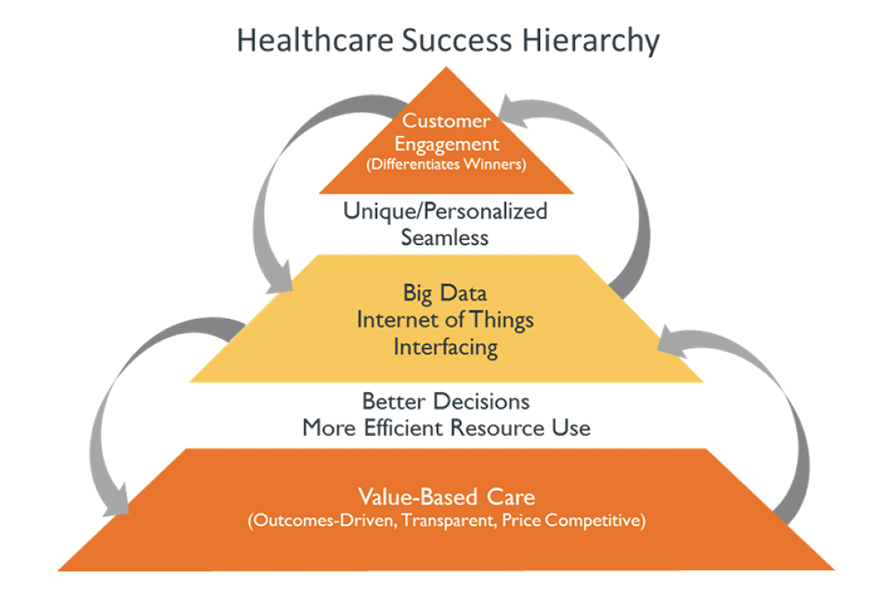Interoperability
Interoperability
Massive changes in healthcare delivery, regulation, and payment make connectivity and integration more important than ever. Collaboration can be among patients and doctors, among hospital staff, and among hospitals and other healthcare organizations—including insurance companies. APIs are a great tool in facilitating this collaboration.
Join this webinar to learn about Red Hat® integration technologies that provide healthcare business value beyond integration and API engines to support value-based and patient-centered care, healthcare Internet of Things (IoT), and other emerging healthcare goals.
Interoperability
Leading healthcare providers across the globe place a constant focus on innovation around all aspects of the care continuum. Medical imaging is no exception to that, particularly when grappling with growing data volume, patient consumerism, and shifting trends of care models. Tune in to learn how healthcare leaders are re-thinking their image management strategies, particularly with an eye to leverage image data as an immutable asset, streamline patient care, and improve interoperability.
Electronic Health Records
VA Secretary David Shulkin is currently in the process of deciding among electronic health record alternatives for the future. Here are the main aspects VA should take into account when making its pick.
Medical devices have pervaded healthcare like never before and have revolutionized patient care. This comes with its own set of challenges though, for healthcare providers and device manufacturers, including Asset Management, Device Security, Regulatory Compliance, and OEM Integration. This webinar will discuss approaches to provide integrated Medical Device Management including the challenges of protecting patients and healthcare institutions data from cybercrime while ensuring and improving compliance over the entire device ecosystem.
During this webinar, you’ll learn how Healthcare organization can:
Save significant time and money by understanding where your devices are and responding quickly and cost effectively to recalls, patches, and device repair issues
Respond quickly and easily to audits from JCAHO and the FDA
Avoid fines and negatively publicity by securing network-connected medical devices
Realize cost savings by combining their IT, Medical Device and Facilities service desks and field services organizations, reducing overhead and improving efficiencies
The countdown to HISS17 continues. As I wrote last week, the best way to think about it is in three ways – education, vendors, and networking. This post is the second in a three-part series – focusing on vendors.
If you already registered, you have been inundated with vendor emails and snail mail since then. The ginormous exhibit hall beckons when you get to Orlando. So how do you make the vendor aspect of HIMSS17 as productive as you can?
Here are some tips to consider based on many years of navigating the exhibit floor:
Meeting with your current vendors – I’ve talked with colleagues in the past who always start here. They schedule meetings in advance or stop by just to say hello at all their primary vendors’ booths. I never fully understood this. Maybe I was a CIO in an organization with mostly internally developed systems for too long. You can connect with your primary vendors throughout the year so do you really have to spend a lot of time with them at HIMSS? It’s up to you and your specific needs and issues. If you want to see the latest and greatest products available or coming in the next year OR you have some big issues to discuss with their executives, it makes sense.
Visiting vendors that you are evaluating – IT teams are in the planning phase for new systems all the time. If you are using HIMSS to check out the market in a focused product area, this is a great chance to get the lay of the land. Scheduling meetings and demos in advance makes sense.
Exploring new products – You might be curious as to what new start-ups and innovators are doing and have a list of small firms to check out. You’ll have to work to find them since the big, established vendors buy the best floor space. But do find them – they will most likely be swarming with booth staff ready to talk to you.
Special showcases – Be sure to check out the Interoperability Showcase to see what level of integration is possible these days. And look for the HX360 Innovation Zone where many new start-ups are demonstrating their products.
You control your time – Booth staff are there to get your attention and tell you all about their products and services. They will keep you if you’re willing to stay. But you control your time and your plan. If you just need a quick informational conversation, want to pick up some materials, and leave your contact info (or not), then do that. Be polite and respectful but move on when you are ready.
Being recognized – There are lots of ribbons that attendees can wear on their badges. The CIO ribbon is one that CIOs treat differently – some would never wear it because they think they’ll be aggressively approached by everyone on the floor selling something. I am of the mind that by wearing it, booth staff easily see you are a CIO and a decision maker and you might more easily get their attention when you visit them. Go back to my previous point – remember, you control your time and which vendors you talk to.
Divide and conquer – Like my advice on education last week, plan with your team if you are going to meet with certain vendors together or you are splitting them up to cover more ground.
Maps – You can download maps in advance from the conference site. This is especially helpful for planning your time in the exhibit hall. Make your list of vendors to see, mark up the map and break it down in sections for each day.
Social media ambassadors – They can help you prepare, keep up while there, and stay connected afterwards. Follow these influencers to get the most out of HIMSS17.
#HIMSS17 Hashtag Guide – HIMSS has provided a helpful guide that lists key hashtags. Before, during and after the conference these hashtags may be helpful as you focus on what you want to learn about and follow. On both Twitter and LinkedIn, you can find related posts using the hashtags.
And last, but not least, pack comfortable walking shoes – HIMSS conference veterans understand this. New attendees may not. You will easily walk several miles each day between education sessions and exhibits. Practicality not vanity is what attendees need to think about when packing shoes. Ladies, comfortable flats or low heels should rule!
This post was first published on Sue Schade's Health IT Connect blog.
The countdown to HIMSS17 is on. It’s less than three weeks and if you’re anything like me, you’ve not figured out your HIMSS schedule yet. You’re getting those emails from HIMSS and vendors about what to do, starting to see the “HIMSS preview” type articles in your favorite publications.
As the conference website says – 5 days | 300 sessions | 1,200 exhibitors | 45,000 colleagues. It’s as overwhelming as it sounds.
The best way to think about it is in three ways – education, vendors, and networking. This post is the first of a three-part series – focusing on education. After all, you’re paying a hefty registration fee and travel expenses so you should get some education time in, right? It’s not just about the massive exhibit hall and seeing all your friends in the industry!
Bottom line, you need a strategy and a focus. No more getting a big thick conference book to page through in advance – it’s all online for you to peruse and develop your plan. The conference website has education organized by topics, professional roles, specialty education, and types of session.
Here are some tips as you plan your education at HIMSS17:
Sunday pre-conference symposia – if you haven’t registered for one of these yet, consider doing so. They are an additional cost but an excellent full day focus with experts on topics such as cybersecurity, interoperability and health information exchange, nursing informatics, medical device security, and precision medicine.
Keynotes – you should certainly look at the program and decide which ones you’ll try to attend. Remember, the main room can be full with an overflow room. Don’t think you can walk in at the last minute and get a seat.
Session levels – look at the level of the sessions you want to attend — introductory, intermediate, or advanced. This is HIMSS way of helping you figure out if the content is at the right level for you. There is always a “Views From the Top” track which is aimed at senior IT leaders. Don’t be put off; anyone can certainly attend. I’ll be checking them out.
Key topics – Pick a couple focus areas you want to learn about and make sure you get to the best of those sessions. HIMSS helps by organizing sessions under broad topics such as:
clinical and business intelligence
connected health
consumer and patient engagement
health IT public policy
leadership, governance, strategic planning
privacy, security and cybersecurity
process improvement, workflow, change management
With all the changes in DC these days, I will be paying close attention to the public policy ones. And I’m going to see if there is anything in the connected health and consumer and patient engagement areas I want to attend.
Divide and conquer – If you are attending with work colleagues, don’t all go to the same sessions. Plan to go to different ones and share your notes. The most effective IT teams will be working together in the next two weeks to map out their game plan to get the most from their investment.
At this stage, these are the sessions I’m most interested in:
Integrating Technology into Medical Practice for Better Patient Care
The Best Exotic Marigold Hospital: Hilton digital experience
Using Data to Understand the Full Value of Patients
Improving Patient Outcomes and Health Economics through Connected Health Innovation
Welcome to the Age of the Patient: Transform Patient Relationships and Results with CRM
Nationwide Trusted Exchange: Are We There Yet?
This post was first published on Sue Schade's Health IT Connect blog.
Commentary: Time to look beyond EHRs to Direct messaging, natural language processing, rules engine…
While healthcare entities are waiting for EHR vendors to make data more interoperable, a raft of emerging technologies are enabling information exchange in ways that work effectively today, according to Lisa Moon, a partner with the Timmaron Group.
Fully supported, agile, and cost-effective, Red Hat® JBoss® Fuse is a lightweight integration platform based on industry standards, making it ideal for healthcare organizations that want to move into the future. With broad connectivity and support for Health Level 7 (HL7) transaction sets and more than 150 standard connectors, Red Hat JBoss Fuse can help you streamline operations, simplify development and deployment, and easily adapt to industry changes.
The EHR vendor’s chief executive weighs in on the industry's most exciting opportunities to improve care ahead of HIMSS17 and into the future.
"Data is the currency of the next century," says Brian Ahier. And nowhere are health data and data management processes discussed, analyzed and examined more than at the HIMSS Annual Conference and Exhibition.









